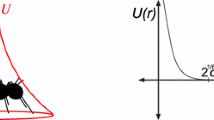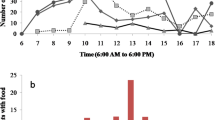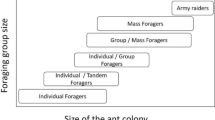Abstract
We present field experiments and analyses that test both the assumptions and the predictions of a model that showed how the swarm raids of the army ant Eciton burchellimight be self-organizing, i.e., based on hundreds of thousands of interactions among the foraging workers rather than a central administration or hierarchical control. We use circular mill experiments to show that the running velocity of the ants is a sigmoidal function of the strength of their trail pheromones and provide evidence that the swarm raid is structured by the interaction between outbound and inbound forager traffic mediated by the pheromones produced by both of these sets of ants. Inbound traffic is also affected by the distribution of prey, and hence, sites of prey capture alter the geometry of the raid. By manipulating the prey distributions for E. burchelliswarms, we have made them raid in a form more typical of other army ant species. Such self-organization of raids based on an interaction between the ants and their environment has profound consequences for interpretations of the evolution of army ant species.
Similar content being viewed by others
References
Burton, J. L., and Franks, N. R. (1985). The foraging ecology of the army antEciton rapax: An ergonomic enigma?Ecol. Entomol. 10: 131–141.
Franks, N. R. (1982). Ecology and population regulation in the army ants,Eciton burchelli. In Leigh, E. G., Jr., Rand, A. S., and Windsor, D. W. (eds.),The Ecology of a Tropical Forest, Smithsonian Institute Press, Washington, D.C., pp. 389–395.
Franks, N. R. (1985). Reproduction, foraging efficiency and worker polymorphism in army ants. In Lindauer, M., and Hölldobler, B. (eds.),Experimental Behavioural Ecology, Karl v. Frisch Symposium,Fortschritte der Zoologie, Vol. 31, Fischer Verlag, Stuttgart, New York, pp. 91–107.
Franks, N. R. (1986). Teams in social insects: Group retrieval of prey by army ants (Eciton burchelli, Hymenoptera, Formicidae).Behav. Ecol. Sociobiol. 18: 425–429.
Franks, N. R. (1989). Army ants: A collective intelligence.Am. Sci. 77(2): 138–145.
Franks, N. R., and Bessert, W. H. (1983). Swarm raiding army ants and the patchiness and diversity of a tropical leaf litter ant community. In Sutton, S. L., Chadwick, A. C., and Whitmore, T. C. (eds.),The Tropical Rain Forest, British Ecological Society Symposium, Blackwells, Oxford, U.K., pp. 151–163.
Franks, N. R., and Fletcher, C. R. (1983). Spatial patterns in army ant foraging and migration:Eciton burchelli on Barro Colorado Island, Panama.Behav. Ecol. Sociobiol. 12: 261–270.
Deneubourg, J. L., Goss, S., Franks, N., and Pasteels, J. M. (1989). The blind leading the blind: Modeling chemically mediated army ant raid patterns.J. Insect Behav. 2: 719–725.
Deneubourg, J. L., Aron S., Goss, S., and Pasteels, J. M. (1990). The self-organizing exploratory patterns of the Argentine ant.J. Insect Behav. 3: 159–168.
Goss, S., Beckers, J. L., Deneubourg, J. L., Aron, S., and Pasteels, J. M. (1990). How trail laying and trail following can solve foraging problems for ant colonies. In Hughes, R. N. (ed.),Behavioural Mechanisms of Food Selection, NATO ASI Series Vol. G 20, Springer-Verlag, Berlin, Heidelberg, pp. 661–677.
Hölidobler, B., and Wilson, E. O. (1990).The Ants, Belknap Press of Harvard University Press, Cambridge, Mass.
Schneirla, T. C. (1933). Studies on army ants in Panama.J. Comp. Psychol. 15: 267–299.
Schneirla, T. C. (1938). A theory of army ant behavior based upon the analysis of activities in a representative species.J. Comp. Psychol. 25: 51–90.
Schneirla, T. C. (1944). A unique case of circular milling in ants, considered in relation to trail following and the general problem of orientation.Am. Mus. Novit. No. 1253: 1–26.
Schneirla, T. C. (1971). In Topoff, H. R. (ed.),Army Ants: A Study in Social Organization, W. H. Freeman, San Francisco.
Topoff, H. R., and Mirenda, J. (1980a). Army ants do not eat and run: Influence of food supply on emigration behaviour inNeivamyrmex nigrescens.Anim. Behav. 28(4): 1040–1045.
Topoff, H. R., and Mirenda, J. (1980b). Army ants on the move: Relation between food supply and emigration frequency.Science 207: 1099–1100.
Author information
Authors and Affiliations
Rights and permissions
About this article
Cite this article
Franks, N.R., Gomez, N., Goss, S. et al. The blind leading the blind in army ant raid patterns: Testing a model of self-organization (Hymenoptera: Formicidae). J Insect Behav 4, 583–607 (1991). https://doi.org/10.1007/BF01048072
Accepted:
Issue Date:
DOI: https://doi.org/10.1007/BF01048072




